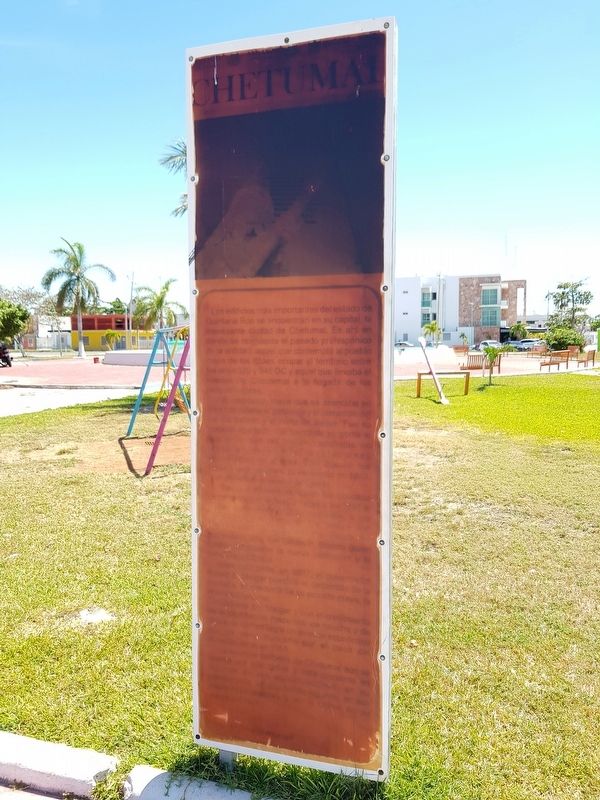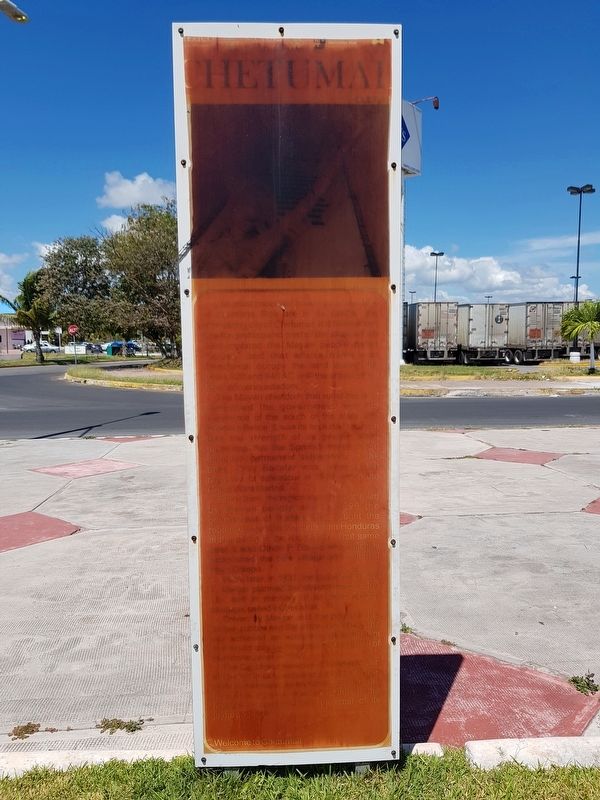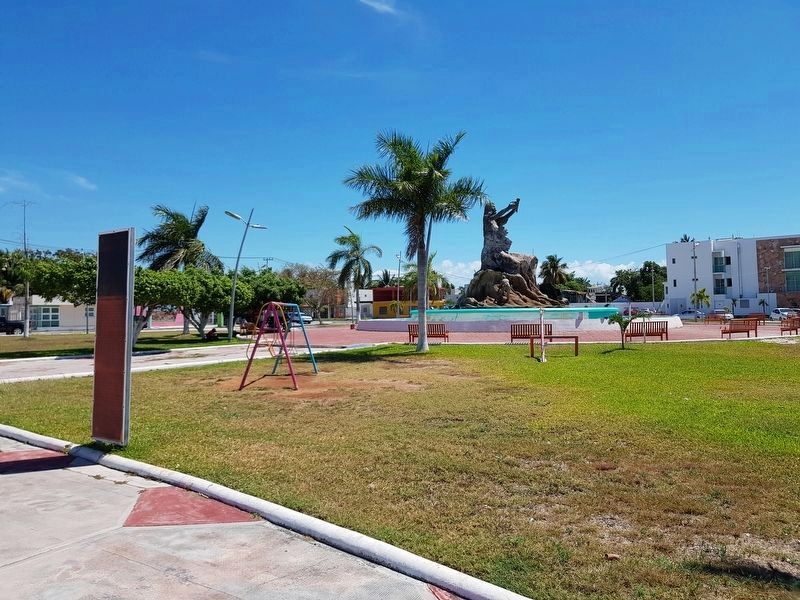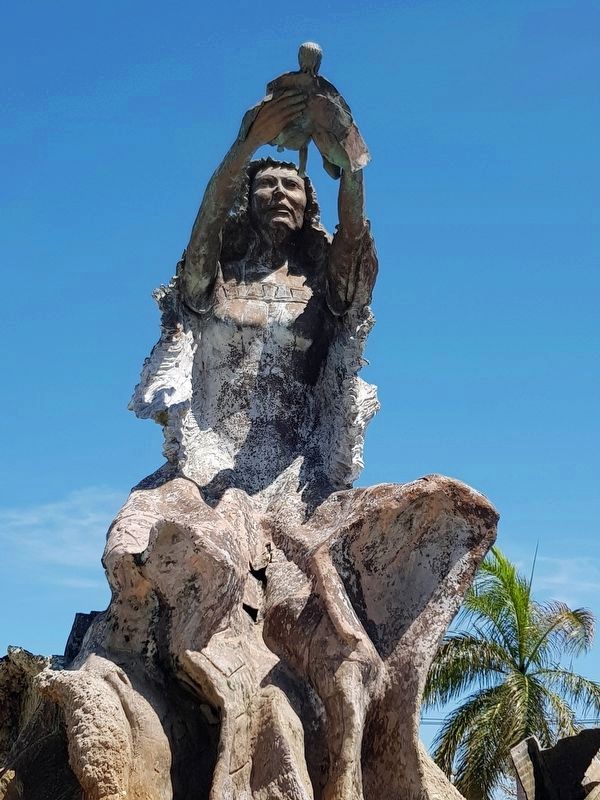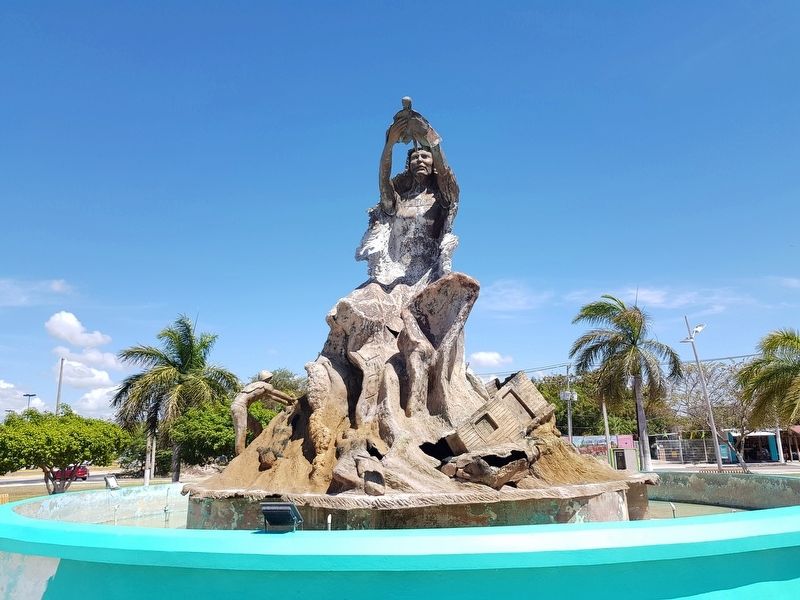Chetumal in Othón P. Blanco, Quintana Roo, Mexico — The Yucatan Peninsula (The Southeast)
Chetumal
Inscription.
Los edificios más importante del estado de Quintana Roo se encuentran en su capital, la interesante ciudad de Chetumal. Es ahí en donde se resguarda el pasado prehispánico de la entidad, aquel que contempló al pueblo maya de los Itzáes ocupar el territorio entre los años 320 y 946 DC y aquel que llevaba el nombre de Chactemal a la llegada de los conquistadores.
El cacicazgo maya que se asentaba en área controlaba el gobierno y el comercio del sur del Estado y el norte de Belice. Fue su territorio apartado y la fuerza de su gente lo que evitó que las tropas españolas no lograron establecer poblaciones en el área. Sólo Bacalar fue tomado pero recuperó su esplendor en 1848, cuando estalló la Guerra de Castas.
Desde entonces, la región fue ocupada únicamente por el pueblo maya y en 1898 el gobierno de Porfirio Díaz combatió a los rebeldes para establecer los límites con Honduras en las aguas del Río Hondo. En el mismo año, fue Othón P. Blanco quien fundó oficialmente la nueva población y la llamó Payo Obispo.
Años más tarde, en 1937, el gobernador Rafael E. Melgar planificó el desarrollo de la ciudad y, en memoria de su pasado maya, la nombró Chetumal.
Impulsada por Melgar y con el crecimiento de la explotación maderera, de caucho y de chicle, la ciudad logra un avance económico que se vería truncado por el paso de Huracán Janet en 1955.
La esencia caribeña de Chetumal aún respira por sus calles y está presente en algunas de sus construcciones, en su gastronomía, en sus bellas lagunas, en sus cenotes misteriosos y en el ánimo de su alegre población.
¡Bienvenidos a Chetumal!
Chetumal
The most important buildings of the state of Quintana Roo are in its capital, the interesting City of Chetumal. It is here where lies the prehispanic past of the state which contemplated the Mayan people called Itzaes and that whose name was Chactemal, occupy the land during the year 320 and 946 AC until the arrival of the Spanish conquistadors.
The Mayan chiefdom that ruled the land controlled the government and the commerce of the south of the state and northern Belize. It was its secluded location and the strength of its people what prohibited that the Spanish troops could establish permanent settlements in the area. Only Bacalar was taken but it regained its splendor in 1848 when the Caste Wars started.
Since then the region was only occupied by Mayan people and in 1898 the government of Porfirio Díaz fought the rebels to establish the limits with Honduras at the banks of the Rio Hondo. That same year, it was Othón P. Blanco who officially established the new village and called it Payo Obispo.
Years later, in 1937, the governor Rafael E. Melgar planned the development of the City and in memory of his deep Mayan heritage called it Chetumal.
Driven by Melgar and the boom of the lumber, rubber and the chicle industries, the city achieved an incredible development that would only be stopped by the arrival of Hurricane Janet in 1955.
The Caribbean essence of Chetumal can still be felt in the city and in the part of some of the villages, its territorial cuisine, the beautiful forests around it, the mysterious cenotes, and the zest of its joyful population.
Welcome to Chetumal!
Topics. This historical marker is listed in these topic lists: Industry & Commerce • Native Americans • Settlements & Settlers • Wars, Non-US. A significant historical year for this entry is 1848.
Location. 18° 29.629′ N, 88° 18.173′ W. Marker is in Chetumal, Quintana Roo, in Othón P. Blanco. Marker is on Avenida Emiliano Zapata just north of Boulevard Bahía, on the right when traveling north. Touch for map. Marker is in this post office area: Chetumal QR 77000, Mexico. Touch for directions.
Other nearby markers. At least 8 other markers are within walking distance of this marker. Río Hondo (within shouting distance of this marker); Joop Beljön
(approx. 0.4 kilometers away); The Southern Fleet (approx. 0.4 kilometers away); Monument to Nachi Cocom (approx. 0.4 kilometers away); Othón Pompeyo Blanco Núñez de Cáceres (approx. 0.4 kilometers away); Remnants of Chetumal's Sidewalks (approx. 0.4 kilometers away); Payo Enríquez de Rivera (approx. 0.4 kilometers away); Life of the Lighthouse Keeper / Lighthouse Keepers of Chetumal (approx. half a kilometer away). Touch for a list and map of all markers in Chetumal.
Regarding Chetumal. The marker mentions the efforts by Mexico to establish its borders in the area in 1898, but it is probably in error by mentioning Honduras, a country with which Mexico does not have any borders. The marker probably refers to British Honduras, the previous name of Belize. The Río Hondo forms the border here between Mexico and Belize.
This marker is repeated further east along Boulevard Bahía, near the "Aquí Inicia México" letters.
Credits. This page was last revised on May 19, 2019. It was originally submitted on May 19, 2019, by J. Makali Bruton of Accra, Ghana. This page has been viewed 160 times since then and 11 times this year. Photos: 1, 2, 3, 4, 5. submitted on May 19, 2019, by J. Makali Bruton of Accra, Ghana.
